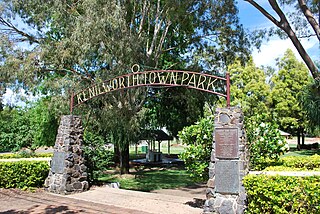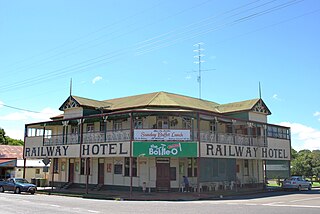
Gympie is a city and a locality in the Gympie Region, Queensland, Australia. In the Wide Bay-Burnett District, Gympie is about 170.7 kilometres (110 mi) north of the state capital, Brisbane. The city lies on the Mary River, which floods Gympie occasionally. The locality of Gympie is the central business district for the city of Gympie and also the administrative centre for the Gympie Region local government area. As of June 2021, Gympie had a population of 53,851.

Kenilworth is a rural town and locality in the Sunshine Coast Region, Queensland, Australia. In the 2016 census, the locality of Kenilworth had a population of 558 people.

Kandanga is a town and a locality in the Gympie Region, Queensland, Australia. In the 2016 census, the locality of Kandanga had a population of 665 people.

The Mary River is a major river system in the South East and Wide Bay–Burnett regions of Queensland, Australia.

The Mary Valley Rattler is a heritage railway line that conducts steam train trips and tours from Gympie through the Mary Valley using the former Mary Valley railway line in the Gympie Region, Queensland, Australia. It is now one of the region's biggest tourist attractions and is managed by a not-for-profit organisation. It has been described as Australia's third biggest heritage railway. It was shut down for safety reasons in 2012. In 2016, the Gympie Regional Council provided funding to make the railway operational again as it is a major tourist attraction for the area. Journeys recommenced between Gympie and Amamoor on 6 October 2018.

The Gympie Region is a local government area in the Wide Bay–Burnett region of Queensland, Australia, about 170 kilometres (110 mi) north of Brisbane, the state capital. It is between the Sunshine Coast and Hervey Bay and centred on the town of Gympie. It was created in 2008 from a merger of the Shires of Cooloola and Kilkivan and part of the Shire of Tiaro.
Traveston Crossing Dam was a proposed water project that was initiated by the state government of Queensland, Australia, in 2006 as a result of a prolonged drought which saw South-East Queensland's dam catchment area receive record-low rain. The project was cancelled in November 2009, after being refused approval by federal Environment Minister Peter Garrett.

Monkland is a rural locality in the Gympie Region, Queensland, Australia. In the 2016 census Monkland had a population of 1,125 people.

Brooloo is a rural town and locality in the Gympie Region, Queensland, Australia. In the 2016 census, the locality of Brooloo had a population of 348 people.

Imbil is a rural town and locality in the Gympie Region, Queensland, Australia. In the 2016 census, Imbil had a population of 924 people.

Amamoor is a rural town and locality in the Gympie Region, Queensland, Australia. In the 2016 census the locality of Amamoor had a population of 636 people.

Gympie railway station is an Australian heritage-listed former railway station in Gympie, Queensland, on the North Coast line. It was the primary railway station serving Gympie from 1881 until 1989.
The Dingo Creek Wine, Jazz & Blues Festival is a music festival in Australia at the Dingo Creek Vineyard at Traveston, Queensland, south of Gympie.

Traveston is a rural town and locality in the Gympie Region, Queensland, Australia. In the 2016 census the locality of Traveston had a population of 480 people.

Imbil Railway Bridge is a heritage-listed railway bridge over Yabba Creek, Imbil, Gympie Region, Queensland, Australia. It was built circa 1915 by Queensland Railways to facilitate settlement in the Mary River Valley. It was added to the Queensland Heritage Register on 14 October 2011.
Mary Valley Railway Cream Sheds are heritage-listed sheds at Kandanga railway station, Amamoor railway station and Melawondi railway station, all of them on the Mary Valley Branch Railway, Mary Valley, Gympie Region, Queensland, Australia. They were designed and built by Queensland Railways. They were added to the Queensland Heritage Register on 14 October 2011.
Bollier is a rural locality in the Gympie Region, Queensland, Australia. In the 2016 census Bollier had a population of 200 people.
The Gympie Local Heritage Register is a list of heritage sites within the Gympie Region, Queensland, Australia. It is maintained by the Gympie Regional Council.
Gympie–Brooloo–Kenilworth Road is a continuous 51.6 kilometres (32.1 mi) road route in the Gympie and Sunshine Coast regions of Queensland, Australia. It has two official names, Gympie–Brooloo Road and Kenilworth–Brooloo Road. The entire route is signed as State Route 51.














